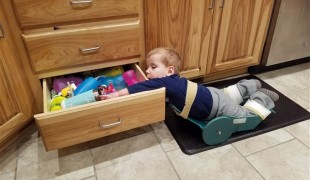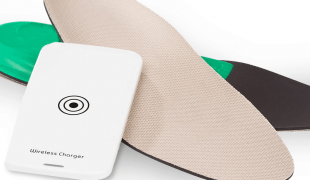- 8289
- 554
- 13
- 15
- 0
- Help Ukraine
About the solution
Chance was born without arms and legs (he doesn’t have legs but has partial feet and arm stumps).
It’s hard for the boy to navigate around their home and engage with other people. There are self-propelled wheelchairs, but no motorised solutions available on the market.
So Chance’s family made a request to charity May We Help (an organisation that develops gadgets to increase the autonomy level of disabled people).
“His only means for transportation is rolling around on the floor or moving around like an inchworm. He is always on the floor. It would be amazing if he could climb into a chair like Jovia’s that would allow him to go outside and go for a walk, to sit up instead of laying on the ground all the time. It would be a significant move towards independence”, they explained.
So Chris Garner, from May We Help, built him a pediatric powerchair, using an adapted pediatric wheelchair, motor, plastic and metal.
The boy got this device in 2015, and thanks to it he is able to independently navigate his environment and participate in activities with his siblings and friends.
Adapted from: https://bit.ly/2WJRhrU
This solution shall not include mention to the use of drugs, chemicals or biologicals (including food); invasive devices; offensive, commercial or inherently dangerous content. This solution was not medically validated. Proceed with caution! If you have any doubts, please consult with a health professional.
DISCLAIMER: This story was written by someone who is not the author of the solution, therefore please be advised that, although it was written with the utmost respect for the innovation and the innovator, there can be some incorrect statements. If you find any errors please contact the patient Innovation team via info@patient-innovation.com
-
-
683
-
0
-
10143

Dad creates device to help 2-year-old son with spina bifida
CAREGIVING
BODY BALANCE: Maintaining body balance
Spinal Cord and Nerve Root Disorders
Assistive Daily Life Device (to help ADL)
Strategy/Tip
Gait abnormalities (e.g., walking difficulties, unsteady gait)
Difficulty coordinating movements
Stiffness or rigidity (difficulty moving)
Paralysis of the legs and lower body
Muscle weakness
Loss of balance
Cognitive impairment
Restoring mobility
Maintaining Balance and Mobility
Preventing (Vaccination, Protection, Falls, Research/Mapping)
Caregiving Support
Medical Genetics
Neurology
Neurosurgery
Pediatrics
United States
-
-
-
310
-
0
-
3539

Teacher Alex Truesdell is Transforming Lives: Adaptive Design Association Revolutionizes Disability Solutions
CAREGIVING
Drawing
Painting
Playing
BODY BALANCE: Maintaining body balance
(SELF)-CARE: DRINKING: Drinking independently.
(SELF)-CARE: EATING: Eating independently.
MOVING IN A WHEELCHAIR: Moving using a wheelchair.
Playing an instrument
Studying
Blindness
Hand Deformity
Neuromuscular Disorders
Assistive Daily Life Device (to help ADL)
Walking Aid (wheelchair/walker/crutches)
Restoring mobility
Replacing lost limbs
Enhancing health literacy
Promoting self-management
Promoting inclusivity and social integration
To improve Treatment/Therapy
Preventing (Vaccination, Protection, Falls, Research/Mapping)
Raise awareness
Caregiving Support
General and Family Medicine
Internal Medicine
Orthopedics
Pediatrics
Physical Medicine and Rehabilitation
United States
-
-
-
425
-
2
-
9518

SmartSole GPS - Tracker for people with Alzheimer's, dementia and autism
COMMUNICATION: Communicating, whether by speaking, listening, or other means
WALKING: Walking
CAREGIVING
Alzheimer's Disease
Dementia (Alcoholic Dementia, Vascular Dementia)
Body-Worn solutions (Clothing, accessories, shoes, sensors...)
Difficulty coordinating movements
Loss of balance
Social withdrawal or isolation
Cognitive impairment
Memory loss
Irritability or anger outbursts
Confusion
Restlessness or feeling slowed down
Anxiety
Panic attacks
Difficulty controlling impulses
Mood swings
Feelings of guilt or worthlessness
Suicidal thoughts or behaviors
Hallucinations (perceiving things that aren't there)
Dizziness or lightheadedness
Fatigue
Restoring mobility
Promoting self-management
Building Supportive Community Relationships
Promoting inclusivity and social integration
Improving Speech and Communication
Preventing (Vaccination, Protection, Falls, Research/Mapping)
Raise awareness
Caregiving Support
Child and Adolescent Psychiatry
General and Family Medicine
Internal Medicine
Medical Genetics
Neurology
Pediatrics
Psychiatry
United States
-
 en
en